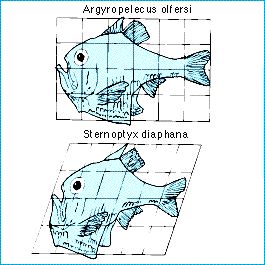Evolutionary developmental biology - How can we study morphological evolution?

D'Arcy Thompson's transformations
Huxley's method works easily for two characters; and its many-dimensioned extension is obvious (just add a third axis for the third character, etc.). However, Multi-dimensional measurement is clumsy for complex shapes.
For complex shapes, D'Arcy Thompson's transformations can be more illuminating. D'Arcy Thompson found that related species superficially looking very different could in some cases be represented as simple Cartesian transformations of one another. With some simplification, the axes on the fish grids in the figure opposite can be thought of as growth gradients. The evolutionary change between the species would then have been produced by a genetic change in the regulatory mechanisms controlling those gradients.
If we looked at Argyropelecus and Sternoptyx but without the grids, we might think that an evolutionary change from one into the other would be at least moderately complicated. The interest of D'Arcy Thompsonís diagrams is then to show that shape changes could have been produced by simple regulatory changes in growth gradients.
Figure: D'Arcy Thompson transformational diagram. The shapes of two pairs of species of fish have been plotted on Cartesian grids. Argyroplecus olfersi could have evolved from Sternoptyx diaphana by changes in growth pattern corresponding to the distortions of the axes.
| Next |



